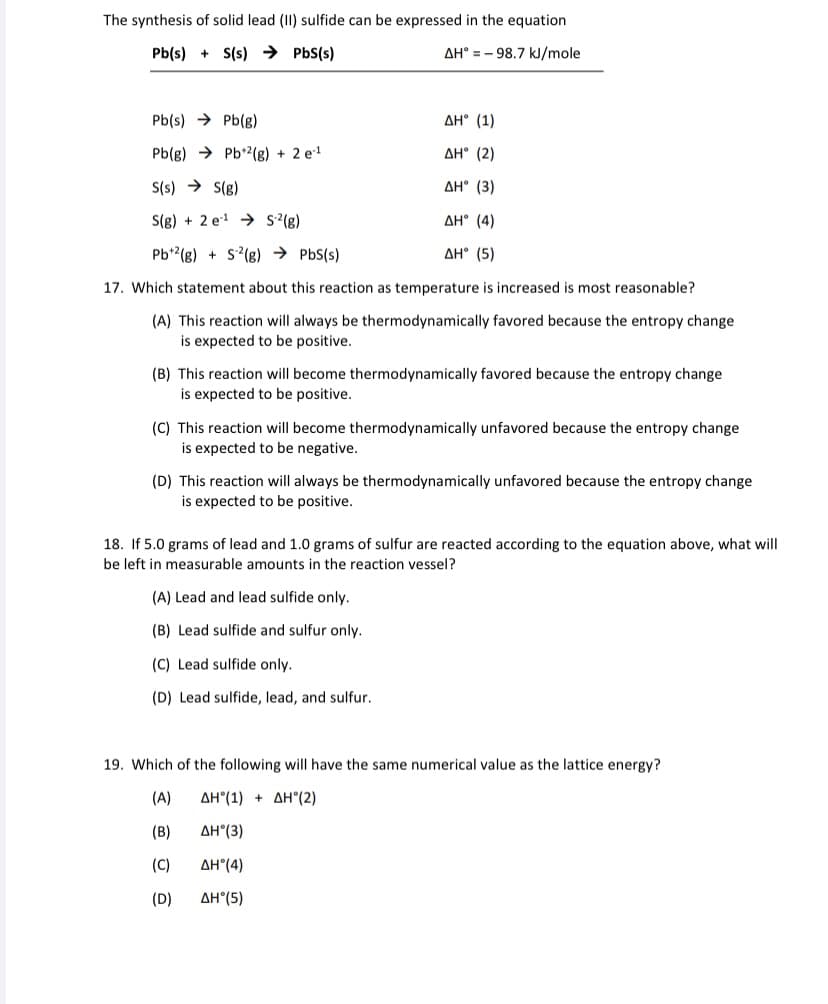The synthesis of solid lead (II) sulfide can be expressed in the equation Pb(s) + S(s) → PbS(s) AH° = - 98.7 kJ/mole Pb(s) → Pb(g) AH° (1) Pb(g) → Pb*(g) + 2 e1 Дн (2) S(s) → S(g) AH° (3) S(g) + 2 e → S(g) AH° (4) Pb (g) + s (g) → PbS(s) Дн (5) 17. Which statement about this reaction as temperature is increased is most reasonable? (A) This reaction will always be thermodynamically favored because the entropy change is expected to be positive. (B) This reaction will become thermodynamically favored because the entropy change is expected to be positive. (C) This reaction will become thermodynamically unfavored because the entropy change is expected to be negative. (D) This reaction will always be thermodynamically unfavored because the entropy change is expected to be positive.
The synthesis of solid lead (II) sulfide can be expressed in the equation Pb(s) + S(s) → PbS(s) AH° = - 98.7 kJ/mole Pb(s) → Pb(g) AH° (1) Pb(g) → Pb*(g) + 2 e1 Дн (2) S(s) → S(g) AH° (3) S(g) + 2 e → S(g) AH° (4) Pb (g) + s (g) → PbS(s) Дн (5) 17. Which statement about this reaction as temperature is increased is most reasonable? (A) This reaction will always be thermodynamically favored because the entropy change is expected to be positive. (B) This reaction will become thermodynamically favored because the entropy change is expected to be positive. (C) This reaction will become thermodynamically unfavored because the entropy change is expected to be negative. (D) This reaction will always be thermodynamically unfavored because the entropy change is expected to be positive.
Chemistry: The Molecular Science
5th Edition
ISBN:9781285199047
Author:John W. Moore, Conrad L. Stanitski
Publisher:John W. Moore, Conrad L. Stanitski
Chapter12: Chemical Equilibrium
Section: Chapter Questions
Problem 85QRT
Related questions
Question

Transcribed Image Text:The synthesis of solid lead (II) sulfide can be expressed in the equation
Pb(s) + S(s) → PbS(s)
AH° = - 98.7 kJ/mole
Pb(s) → Pb(g)
AH° (1)
Pb(g) → Pb*2(g) + 2 e1
AH° (2)
S(s) → S(g)
AH° (3)
S(g) + 2 e1 → s'(g)
AH° (4)
Pb*(g) + S?(g) → PbS(s)
AH° (5)
17. Which statement about this reaction as temperature is increased is most reasonable?
(A) This reaction will always be thermodynamically favored because the entropy change
is expected to be positive.
(B) This reaction will become thermodynamically favored because the entropy change
is expected to be positive.
(C) This reaction will become thermodynamically unfavored because the entropy change
is expected to be negative.
(D) This reaction will always be thermodynamically unfavored because the entropy change
is expected to be positive.
18. If 5.0 grams of lead and 1.0 grams of sulfur are reacted according to the equation above, what will
be left in measurable amounts in the reaction vessel?
(A) Lead and lead sulfide only.
(B) Lead sulfide and sulfur only.
(C) Lead sulfide only.
(D) Lead sulfide, lead, and sulfur.
19. Which of the following will have the same numerical value as the lattice energy?
(A)
ΔΗ (1 ) + ΔΗ"(2)
(B)
AH°(3)
(C)
AH°(4)
(D)
AH°(5)
Expert Solution
This question has been solved!
Explore an expertly crafted, step-by-step solution for a thorough understanding of key concepts.
Step by step
Solved in 2 steps

Knowledge Booster
Learn more about
Need a deep-dive on the concept behind this application? Look no further. Learn more about this topic, chemistry and related others by exploring similar questions and additional content below.Recommended textbooks for you

Chemistry: The Molecular Science
Chemistry
ISBN:
9781285199047
Author:
John W. Moore, Conrad L. Stanitski
Publisher:
Cengage Learning

Chemistry for Engineering Students
Chemistry
ISBN:
9781337398909
Author:
Lawrence S. Brown, Tom Holme
Publisher:
Cengage Learning

Chemistry for Engineering Students
Chemistry
ISBN:
9781285199023
Author:
Lawrence S. Brown, Tom Holme
Publisher:
Cengage Learning

Chemistry: The Molecular Science
Chemistry
ISBN:
9781285199047
Author:
John W. Moore, Conrad L. Stanitski
Publisher:
Cengage Learning

Chemistry for Engineering Students
Chemistry
ISBN:
9781337398909
Author:
Lawrence S. Brown, Tom Holme
Publisher:
Cengage Learning

Chemistry for Engineering Students
Chemistry
ISBN:
9781285199023
Author:
Lawrence S. Brown, Tom Holme
Publisher:
Cengage Learning

General Chemistry - Standalone book (MindTap Cour…
Chemistry
ISBN:
9781305580343
Author:
Steven D. Gammon, Ebbing, Darrell Ebbing, Steven D., Darrell; Gammon, Darrell Ebbing; Steven D. Gammon, Darrell D.; Gammon, Ebbing; Steven D. Gammon; Darrell
Publisher:
Cengage Learning

Chemistry & Chemical Reactivity
Chemistry
ISBN:
9781133949640
Author:
John C. Kotz, Paul M. Treichel, John Townsend, David Treichel
Publisher:
Cengage Learning

Chemistry & Chemical Reactivity
Chemistry
ISBN:
9781337399074
Author:
John C. Kotz, Paul M. Treichel, John Townsend, David Treichel
Publisher:
Cengage Learning